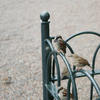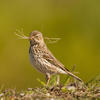You are here
Why birds do not fall while sleeping

It may sound like a tall tale, but that is more or less the one recounted in a recent publication by a team of scientists at the National Museum of Natural History (MNHN) and the CNRS, which explains in the pages of the Journal of the Royal Society Interface1 how birds can sleep while standing, without losing their balance. We know horses and bovines are capable of this feat thanks to their four legs, but at first glance this does not seem so evident for birds. Scientists agree that this stability comes from one thing: tensegrity. Created from the contraction of the words “tension” and “integrity,” tensegrity is the property of a structure to remain stable and balanced thanks to the subtle interplay of tension and compression in the elements of which it is made.
Multi-faceted balance
“The starting point for this research was trying to understand evolutionary mechanisms via functional morphology, which studies the relation between an organism’s form and functioning,” points out Anick Abourachid, a specialist on evolutionary biology, and the Deputy Director of the Adaptive Mechanisms and Evolution research unit2 at the National Museum of Natural History. “We are especially interested in bird feet.” Studying the evolutionary mechanisms in bird feet is of interest because birds are a particularly homogenous group with respect to their structure: “They are all bipedal flying dinosaurs that, since the group’s origin, have shared a structure built to be aerodynamic. They all possess, with no exceptions, a rigid torso,
underparts for landing and taking off, and wings.” What is more, this highly preserved organisational blueprint is effective everywhere, as it can be found in birds living in all environments. “It is this versatility that has always interested and intrigued me. It was while discussing with my colleagues Philippe Wenger and Christine Chevallereau that I learned of the existence of tensegrity, mechanical systems entirely maintained by tension.”
It should be noted that bird feet are distinctive because they are close, from a structural point of view, to human legs. “Birds are flexed bipeds, which is to say that when they are standing, their entire body is bent. For humans this is the equivalent of a posture crouching on one’s toes.” This posture does not at first glance appear to be comfortable, but birds relax in this position, and can even sleep while standing; in short, they are at rest, and consequently consume less energy. To understand how birds achieve this balance, the scientists conceived a digital model based on the anatomy of a small bird, the mandarin diamondbird (Taeniopygia guttata), a species belonging to the passerine family. “It was by greatly simplifying the body’s system, preserving only what relates to standing posture, that we identified postural stability,” Abourachid reveals.
In this model, the body and foot bones were replaced by bars, and muscles and tendons by more or less rigid cables. The joints between each bone in the feet were replaced by pulleys. “We began the experiments by using a single cable that began at the ‘bird’s’ pelvis and stretched to its feet, passing through all of the joints (hip, knee, ankle), and therefore through all of the pulleys.”
This enabled the researchers to reproduce the generic standing posture of birds, although their rendition was not at all stable, which is surprising given that we see them perched atop electric cables or tree branches without ever falling over. “Our bird model was balanced at only one point in space, whereas birds are naturally balanced in a multitude of positions. So we improved its stability by using multiple cables instead of just one, notably one that runs behind the knee instead of in front, as was the case in the initial model.”



Birds do indeed have a tendon that passes behind the knee, going through a ligament loop that keeps it aligned, a unique anatomical feature. With four cables—one running behind the knee—the model became stable, in other words the system can passively retain balance on its own like a roly-poly toy, even when exposed to a minor disturbance.
Rigidity and reactivity
The scientists also grasped that the quality of the cables–and hence of the tendons in bird feet–played a decisive role. “Birds are among the only animals with calcified tendons that are practically ossified,” explains Christine Chevallereau, a Senior Researcher at the Nantes Laboratory of Digital Science3(LS2N). “In our model, we understood that this property had to be taken into consideration in order to achieve stable balance. The bird needs these stiff tendons, because when it stands, it must offset the effect of gravity in order not to tip over to one side of the branch. While this low elasticity may not seem to contribute to stability, that is not at all the case, for it lessens the effect of the disturbances the bird is subject to. This also allows for a much quicker response from the system, as it will have less of a tendency to deform before returning to its position of balance.” Whether it is snowing, raining, or windy, this tensegrity system allows birds to continue sleeping, without fear of falling from their perch.
“The advantage bird’s derive from the tensegrity in their feet is based on the mechanism’s passive nature. The bird subsequently does not have to think or concentrate to remain standing. Everything is based on the system’s elasticity. This is a kind of embodied intelligence where the body alone solves the problem, with no intervention by the brain, thereby doing so without consuming energy,” Chevallereau adds.



The mechanism’s passive character is surprising, but it paves the way for high-impact applications. “We should remember that these mechanisms are widely used in civil engineering, as they make it possible to lighten a structure. The idea with this discovery is to use such mechanisms in robotics in order to lighten masses in motion, consume less energy, use less materials in construction, and reduce danger in the event of a collision with an operator,” points out Philippe Wenger, a Senior Researcher at LS2N. Engineers have already imagined bipedal robots with tensegrity systems allowing them to maintain a standing posture while balanced on unstable surfaces, and doing so for long periods without consuming the least energy.
- 1. https://royalsocietypublishing.org/doi/abs/10.1098/rsif.2023.0433
- 2. CNRS/MNHN
- 3. CNRS/École centrale de Nantes/Nantes Université.
















